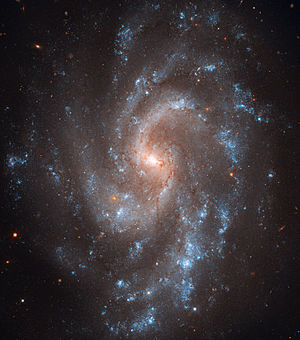NGC 5584
| Galaxie NGC 5584 | |
|---|---|
 | |
| Aufgenommen mit der Wide Field Camera 3 des Hubble-Weltraumteleskops | |
| AladinLite | |
| Sternbild | Jungfrau |
| Position Äquinoktium: J2000.0, Epoche: J2000.0 | |
| Rektaszension | 14h 22m 23,8s[1] |
| Deklination | −00° 23′ 16″[1] |
| Erscheinungsbild | |
| Morphologischer Typ | SAB(rs)cd[1] |
| Helligkeit (visuell) | 11,5 mag[2] |
| Helligkeit (B-Band) | 12,2 mag[2] |
| Winkelausdehnung | 3,4′ × 2,7′[2] |
| Positionswinkel | 140°[2] |
| Flächenhelligkeit | 13,8 mag/arcmin²[2] |
| Physikalische Daten | |
| Rotverschiebung | 0.005464 ±0.000013[1] |
| Radialgeschwindigkeit | (1638 ±4) km/s[1] |
| Hubbledistanz H0 = 73 km/(s • Mpc) | (72 ± 5) · 106 Lj (22,1 ± 1,5) Mpc [1] |
| Durchmesser | 50.000 Lj |
| Geschichte | |
| Entdeckung | Edward Barnard |
| Entdeckungsdatum | 27. Juli 1881 |
| Katalogbezeichnungen | |
| NGC 5584 • UGC 9201 • PGC 51344 • CGCG 019-008 • MCG +00-37-001 • IRAS 14198-0009 • 2MASX J14222381-0023148 • HIPASS J1422-00 • LDCE 1076 NED011 | |
NGC 5584 ist eine Balken-Spiralgalaxie vom Hubble-Typ SBc[2] im Sternbild Jungfrau, die etwa 72 Millionen Lichtjahre von der Milchstraße entfernt ist.
Entdeckt wurde das Objekt am 27. Juli 1881 von Edward Barnard[3].
Weblinks
Einzelnachweise
Auf dieser Seite verwendete Medien
The brilliant, blue glow of young stars trace the graceful spiral arms of galaxy NGC 5584 in this Hubble Space Telescope image. Thin, dark dust lanes appear to be flowing from the yellowish core, where older stars reside. The reddish dots sprinkled throughout the image are largely background galaxies.
Among the galaxy's myriad stars are pulsating stars called Cepheid variables and one recent Type Ia supernova, a special class of exploding stars. Astronomers use Cepheid variables and Type Ia supernovae as reliable distance markers to measure the universe's expansion rate. NGC 5584 was one of eight galaxies astronomers studied to measure the universe's expansion rate. In those galaxies, astronomers analyzed more than 600 Cepheid variables, including 250 in NGC 5584.
Cepheid variables pulsate at a rate matched closely by their intrinsic brightness, making them ideal for measuring distances to relatively nearby galaxies. Type Ia supernovae flare with the same brightness and are brilliant enough to be seen from relatively longer distances.
Astronomers search for Type Ia supernovae in nearby galaxies containing Cepheid variables so they can compare true brightness of both types of stars. They then use that information to calibrate the measurement of Type Ia supernovae in far-flung galaxies and calculate their distance from Earth. Once astronomers know accurate distances to galaxies near and far, they can determine the universe's expansion rate.
The image is a composite of several exposures taken in visible light between January and April 2010 with Hubble's Wide Field Camera 3.
NGC 5584 resides 72 million light-years away in the constellation Virgo.